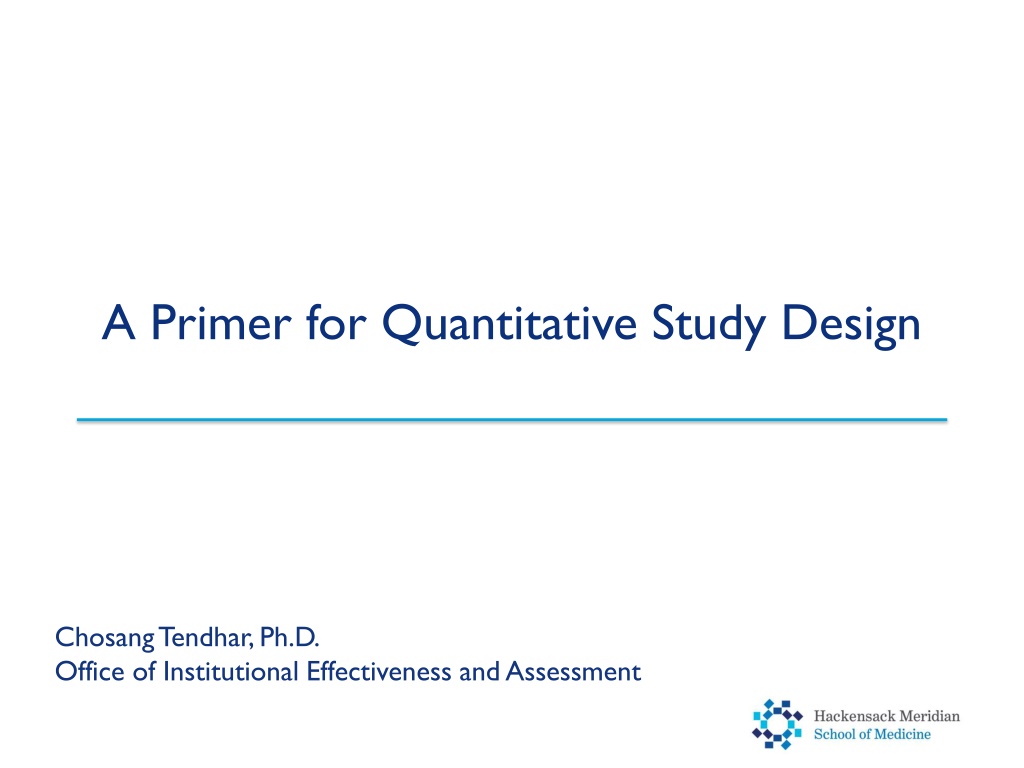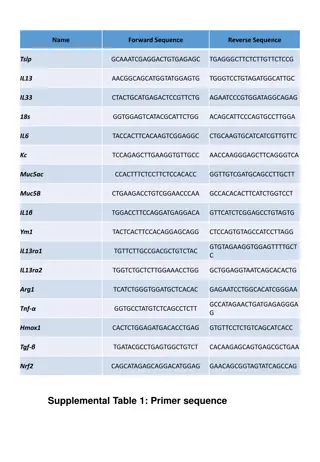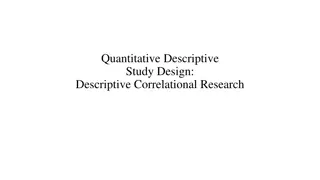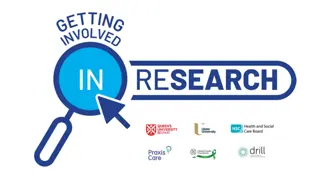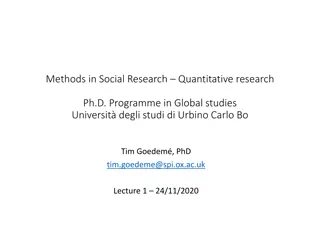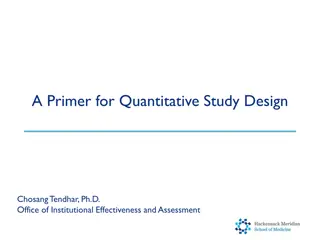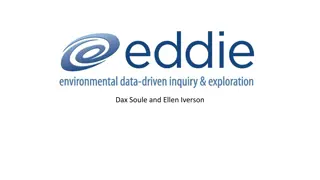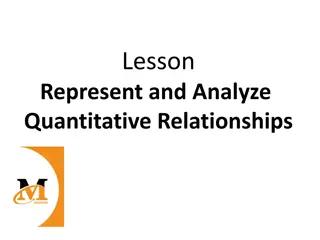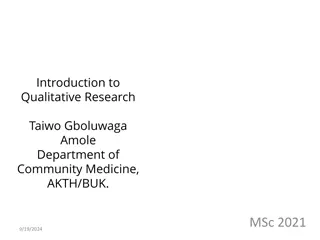A Primer for Designing Quantitative Research Studies
This primer introduces the processes involved in designing a quantitative study, focusing on conceptualization and design basics. It emphasizes the importance of training, coursework, and experience for conducting high-quality scholarly research. The content covers the purpose of the primer, variations in the research process, and the eight stages in the research process, including identifying the problem, reviewing literature, setting objectives, choosing design, data collection, analysis, and reporting. It stresses the significance of clearly defining research problems with specific variables to ensure workability and solvability. Examples are provided to illustrate the importance of formulating research problems effectively.
Download Presentation

Please find below an Image/Link to download the presentation.
The content on the website is provided AS IS for your information and personal use only. It may not be sold, licensed, or shared on other websites without obtaining consent from the author. Download presentation by click this link. If you encounter any issues during the download, it is possible that the publisher has removed the file from their server.
E N D
Presentation Transcript
A Primer for Quantitative Study Design Chosang Tendhar, Ph.D. Office of Institutional Effectiveness and Assessment
Introduction Purpose is to introduce processes involved in designing a quantitative study Number of books on research methods Several primers on research design and analysis Focus is on some of the basics-conceptualization and designing it Takes a rigorous training, extensive coursework, and many years of experience to conduct high quality scholarly research
Introduction (Contd) This primer should serve as a good guide This should enable the readers to pursue additional readings on relevant topics Some variations exist in the research process
Eight Stages in the Research Process i. ii. iii. Identifying the problem Reviewing the literature Setting research questions, objectives, and hypotheses Choosing the study design Deciding on the sample design Collecting data Processing and analyzing data Writing the report iv. v. vi. vii. viii.
i. Identifying the Research Problem Most important step in the scholarly research endeavors A problem well put is half solved Research problem statement indicates overall direction of the study Usually rather general Scope of the study to be appropriate
Identifying the Research Problem (Contd) Broad questions tend to lead to vague answers Research problems should be workable and solvable with relationships between specific variables clearly established Examples The purpose of this study is to examine the relation between teaching style and student academic achievement This study investigates the effect of sex on aggression
Sources for Problems Investigator s interest and experience Theory Replication Clarification of contradictory findings
ii. Review of Literature Conduct a thorough review of the relevant literature Past research on the phenomenon under study play a key role in the process of problem formulation and the design of a study Sources of research problems extend beyond the existing literature Benefit - an extensive review of the literature will enable researchers to demonstrate the significance of their studies Sharing the piece(s) of the puzzle their studies contribute to the existing knowledge base
Review of Literature (Contd) Literature review should not be restricted to one s own discipline and subdiscipline It is important to break out of the almost inevitable parochialism that training and specialization engender Failure to do so will foster tunnel vision Detrimental to cumulative knowledge
Review of Literature (Contd) Interdisciplinary studies are more impactful Medical education overlaps with educational research in general, and particularly with other professional education, such as engineering education Study of professional identity formation is an emerging theme within the medical education community There is a rich literature on the professional identity formation as a construct in engineering education Medical education stands to gain if we integrate literature from other fields in addressing medical education research questions
Review of Literature (Contd) Some of the core purposes of reviewing literature include: Refining the research problem Establishing the conceptual or theoretical orientation Identifying contradictory findings Developing research hypotheses Learning about new information
iii. Research Questions, Objectives, and Hypothesis Researcher presents specific and narrow questions to obtain measurable and observable data Researchable question is one that can be investigated empirically Example of a researchable question What is the effect of sex on aggression? Questions with appropriate level of specificity and knowledge of the current literature Enable a researcher to develop hypothesis and identify IV and DV
Definitions Hypothesis: A hypothesis is a conjectural statement about a relation between two or more variables, or about how the variables in the study are related In research, a hypothesis is typically the investigator s prediction or expectation of what the results will show Such a prediction is made prior to data collection Example: There is a significant difference between males and females in aggression and that males tend to be more aggressive
Definitions (Contd) Variable: A variable is a characteristics or attributes of an individual or organization that researchers can measure or observe and varies among the individuals or organizations Examples: Intelligence, achievement, and cognitive style Categorical Variable: A categorical variable is used to assign an object or person to a group (level) defined by having specified characteristics Examples: sex, race, socioeconomic status (SES), voting preference, and religious preference
Definitions (Contd) Continuous Variable: A continuous variable reflects an infinite number of values within a given range of scores They can assume any value along a scale of values such as height (inches), weight (pounds), time (in seconds), or income. Independent Variable: An independent variable is an attribute or characteristic that influences or affects an outcome or dependent variable
Definitions (Contd) Dependent Variable: A dependent variable is an attribute or characteristic that is dependent on, or influenced by, the independent variables. This is generally the variable that the researcher wants to measure or predict Confounding Variable: Confounding variables are attributes or characteristics that the researcher does not directly measure, but that may influence the relationship between the independent and dependent variables
iii. Research Questions, Objectives, and Hypothesis (Contd) Researchers should be clear in their minds and research questions concerning the relationship between their variables Which ones are doing the influencing (independent) Which one are being affected (dependent) Predictions are made from independent variables to dependent variables
iv. Choosing the Study Design A research design is a set of procedures that researchers use to collect, analyze, and report their data in a research study Quantitative research designs are a set of procedures for collecting, analyzing, and reporting numeric data Three broad classes of designs Experimental Quasi-experimental Non-experimental What serves to distinguish among the three classes of designs is the presence or absence of (a) manipulation of IVs, and (b) randomization
Three Designs Experimental Design: An experiment is a study in which at least one variable is manipulated, and units are randomly assigned to the different levels or categories of the manipulated variable(s) Seek to understand causal relationships among variables of interests Quasi Experimental Design: Refers to investigations in which treatments are administered but randomization is absent Nonexperimental Design: In nonexperiment, both manipulation and randomization are absent
v. Sample Design A sample design refers to the methods to be followed in selecting a sample from the population The purpose of sampling in quantitative studies is to obtain a group of participants who will be representative of a larger group of individuals The degree of representativeness and the quality of the information obtained are based on the sampling techniques employed
v. Sample Design (Contd) Two major types of sampling procedures: Probability sampling and non-probably sampling Qualitative studies non-probability sampling Quantitative studies probability sampling More rigorous Examples: simple random sampling, systematic sampling, and stratified sampling Each individual has a known chance (or probability) of being selected
vi. Collecting Data Researchers use instruments to measure the variables in the study An instrument is a tool for recording quantitative data It contains specific questions and response possibilities Examples of instruments: Survey questionnaire, checklists that can be used to observe an individual s behaviors, standardized tests, secondary data analysis, and structured interviews
vii. Processing and Analyzing Data In quantitative research, researchers analyze the data using mathematics procedures, called statistics Separate primer on statistics Many might know how to calculate correlation coefficient or perform a t-test, but not all of them might be able to pick an approach that is appropriate to address a particular research question A statistical technique to be used will be determined by the research question
vii. Processing and Analyzing Data Depending on the sample size, it is important to understand when to use parametric tests or non- parametric tests It is helpful to have a familiarity with the parametric techniques and their non-parametric techniques counterparts
vii. Writing Reports The entire research process culminates in a report that is disseminated to audiences The overall format for a report of quantitative study follows a predictable pattern: Introduction, literature review, methods, results, and conclusions Essentially all of the steps involved in conducting research, discussed above
Concluding Thoughts See experienced researchers with quantitative analytic skills during the early stage of your planning process Ensure that the research questions and hypotheses are testable Use a reliable and validated instrument or develop an instrument that adheres to fundamental principles of scale constructions Keep in mind that fancy statistics and expensive statisticians will not enhance the quality of your paper
Concluding Thoughts (Contd) Quality Indicators: Researchable question An adequate literature review Sound theoretical framework Reliable and validated instruments Appropriate data for your research questions Accurate and plausible inferences from your results Will strengthen the quality of your paper Such a study will make significant contributions to the current body of knowledge
